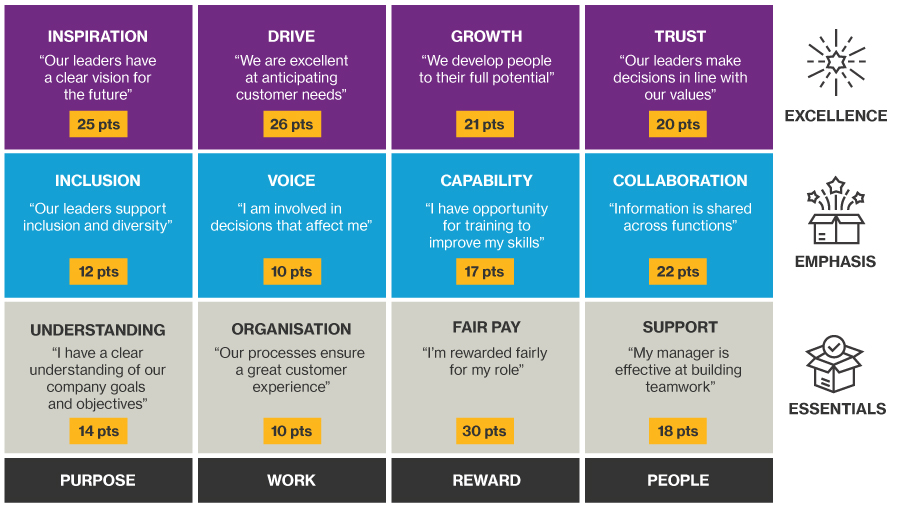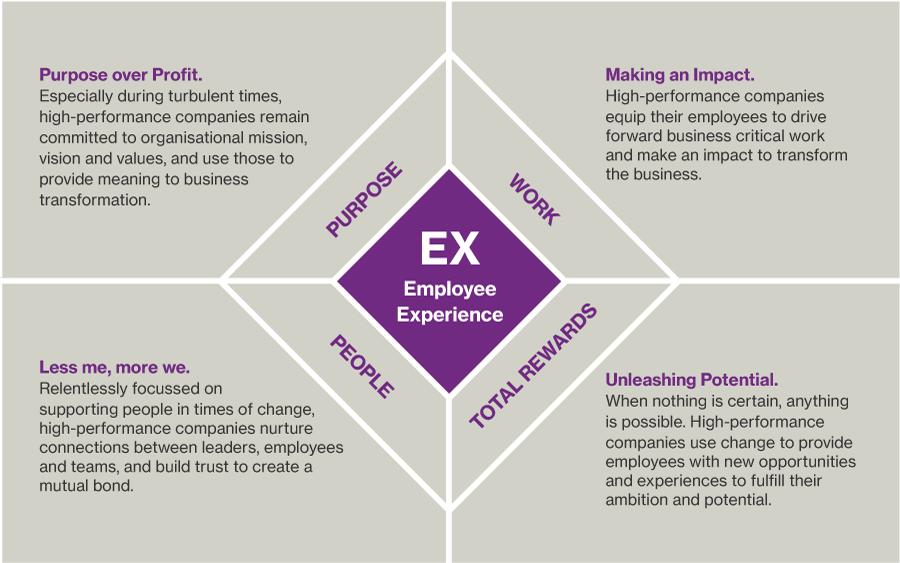Part of the Transform to Perform series
As organisations adapt, pivot, grow and shrink, periods of change fundamentally impact the employee experience (EX). People are being asked to think, interact and act in new ways, disrupting how employees experience work, and how they feel about their role and their future.
When there is an imperative for reinvention, successful organisations manage the changes thoughtfully by involving, supporting and engaging with their employees through the change, particularly during a crisis. And in doing so, they create an employee experience that helps their people thrive, delights their customers and delivers outstanding performance.
Our research tells us that employees are looking for two fundamental experiences from work:
These are reflected in the four core pillars of employee experience – Purpose, Work, Reward and People. Leaders have a clear role in shaping the employee experience, and in shaping the underlying culture that underpins a positive experience. This role takes on even more weight when leading through a time of transformation.
By blending these four dimensions with levels of differentiation, a model of the full landscape of employee experience emerges. We call this the High-Performance Employee Experience (HPEX) model.
So how can the HPEX model and this knowledge help you navigate through change successfully?
To illustrate the impact and help our clients with this challenge, we created a blueprint of organisations who are undergoing change more effectively (the Change masters) and compared them with other organisations who are also tackling transformation across the 12 HPEX topics.

In the Purpose steam, for Inspiration, "Our leaders have a clear vision for the future" 25 points. For Inclusion, "Our leaders support inclusion and diversity" 12 points. For Understanding, "I have a clear understanding of our company goals and objectives" 14 points.
In the Work stream, for Drive, "We are excellent at anticipating customer needs" 26 points. For Voice, "I am involved in decisions that affect me" 10 points. For Organisation, "Our processes ensure a great customer experience" `10 points.
In the Reward stream, for Growth "We develop people to their full potential" 21 points. For Capability, "I have opportunity for training to improve my skills" 17 points. For Fair Pay, "I'm rewarded fairly for my role" 30 points.
In the the final steam, People, for Trust "Our leaders make decisions in live with our values" 20 points. For Collaboration, "Information is shared across functions" 22 points. For Support, "My manager is effective at building team work" 18 points.
We found that companies going through significant transformation often struggle to maintain a favourable employee experience. The numbers in the orange boxes in the Figure 01 show the size of the differences (percentage points favourable) in employee opinion between change masters vs the typical organisation undergoing transformation. As you can see where those highly effective at managing change outperform those struggling to transform the most are in the hallmarks of excellence (inspiration, drive, growth and trust), with differences in the experience 20% or higher. These are coupled with significant challenges around collaboration, capability and pay perception.
Through looking at where the Change masters excelled, it was evident that companies can manage transformation AND deliver a high-performance employee experience, even in areas where they typically struggle. Compared to those struggling with transformation, companies effective at managing change differentiate themselves most by their unwavering focus on the market. They provide an inspiring vision, encourage collaborative efforts, reward employees for their contribution towards that end and help employees power their personal ambition through new opportunities uncovered through the change.
Unprecedented is a much-used phrase at the moment, but these times are creating the imperative for change. Doing so without a focus on the impact on employee experience comes with considerable risk to productivity, engagement and profit as illustrated in Figure 02.

The first quadrant, Purpose. Purpose over Profit.
Especially during turbulent times, high-performance companies remain committed to organisational mission, vision and values, and use those to provide meaning to business transformation.
The second quadrant, Work. Making an Impact.
High-performance companies equip their employees to drive forward business critical work and make an impact to transform the business.
The third quadrant, People.Less me, more we.
Relentlessly focused on supporting people in times of change, high-performance companies nurture connections between leaders, employees and teams, and build trust to create a mutual bond.
The fourth and final quadrant, Total Rewards. Unleashing Potential. When nothing is certain, anything is possible. High-performance companies use change to provide employees with new opportunities and experiences to fulfil their ambition and potential.
The most profound change comes through a transformation of mindset – inspiring your organisation around your purpose, driving agility and innovation to be ahead of the market, helping your people achieve their potential and building a trusting leadership environment. The fact that so few organisations do this well suggests it is hard. But it is the ultimate magic key to unlocking high performance, even now.